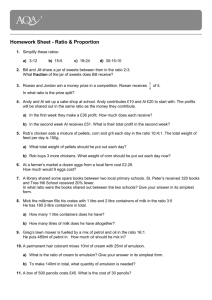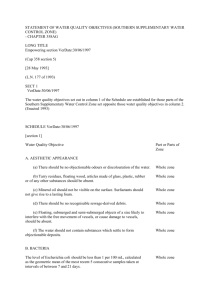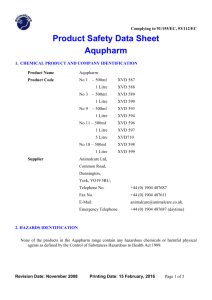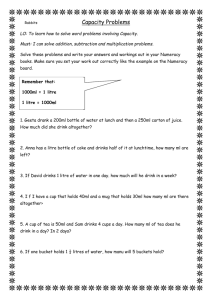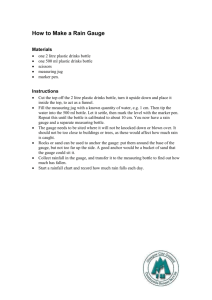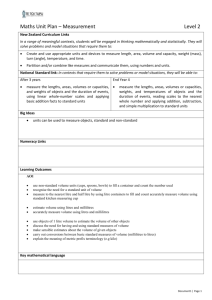Year 2 Teaching Sequence xxx
advertisement
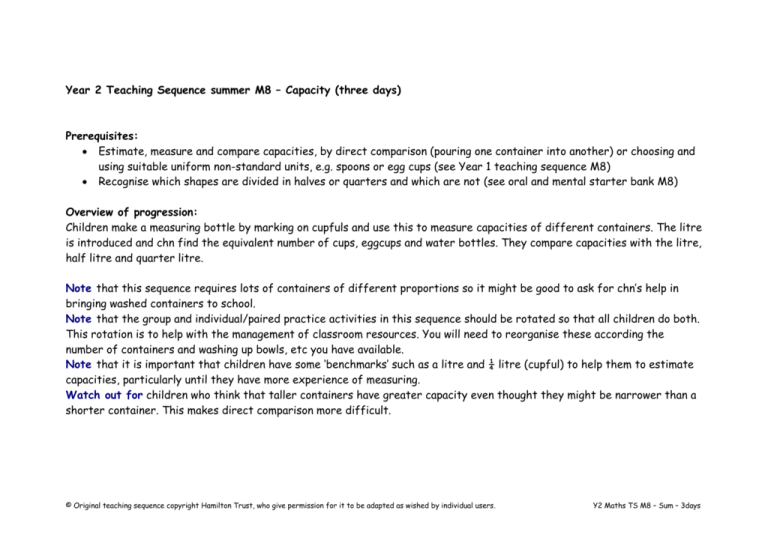
Year 2 Teaching Sequence summer M8 – Capacity (three days) Prerequisites: Estimate, measure and compare capacities, by direct comparison (pouring one container into another) or choosing and using suitable uniform non-standard units, e.g. spoons or egg cups (see Year 1 teaching sequence M8) Recognise which shapes are divided in halves or quarters and which are not (see oral and mental starter bank M8) Overview of progression: Children make a measuring bottle by marking on cupfuls and use this to measure capacities of different containers. The litre is introduced and chn find the equivalent number of cups, eggcups and water bottles. They compare capacities with the litre, half litre and quarter litre. Note that this sequence requires lots of containers of different proportions so it might be good to ask for chn’s help in bringing washed containers to school. Note that the group and individual/paired practice activities in this sequence should be rotated so that all children do both. This rotation is to help with the management of classroom resources. You will need to reorganise these according the number of containers and washing up bowls, etc you have available. Note that it is important that children have some ‘benchmarks’ such as a litre and ¼ litre (cupful) to help them to estimate capacities, particularly until they have more experience of measuring. Watch out for children who think that taller containers have greater capacity even thought they might be narrower than a shorter container. This makes direct comparison more difficult. © Original teaching sequence copyright Hamilton Trust, who give permission for it to be adapted as wished by individual users. Y2 Maths TS M8 – Sum – 3days Objective: Estimate, measure and compare capacities, choosing and using suitable non-standard and standard units and suitable measuring instruments Whole class Group activities Paired/indiv practice Resources Show chn a 2 litre plastic bottle with a strip of paper glued to one side, from the bottom to near the top. Stand it in a washing up bowl to catch any spillages. Ask a child to fill a plastic cup with coloured water and pour it into the plastic bottle. They mark on the strip of paper where it comes to and write ‘1’. Ask another child to do the same and write ‘2’. Repeat until no more whole cups of water will fit (around 8). Empty the water out. We’ve made a measuring bottle. We can use this to find out how much water containers can hold; we call this their capacity. Show children a water jug. How many cupfuls of water do you think this might hold? Less than 5? Between 5 and 10? More than 10? Take chn’s suggestions and then ask a child to fill the jug with water and carefully pour the water into the measuring bottle. So what is the capacity of this jug to the nearest cupful? Read this off the scale, then fill the cup and tip into the jug until it is full to confirm that this is the same number of cups. Group of 4-5 children Task A: Chn work in pairs to make their own measuring bottle as in the whole class teaching. They discuss how many cupfuls each of four containers might hold and record this in a table: Container Estimate Measure Mug Water bottle Jug Vase They then use their measuring bottle to measure the capacity of each to the nearest cupful. Harder: Chn measure capacity to the nearest half cupful. Task B: Chn match capacities (in cupfuls) to containers of different proportions. They write the names of the containers in order of capacity from the least to the greatest (see Activity sheet). Harder: Chn also think of a container with less capacity than any of the containers and one with greater capacity. 2 litre mineral water or pop bottles with strips of paper for a scale (these could be laminated to lessen water damage) Food colouring Washing up bowls Plastic cups Containers with capacities of less than two litres Activity sheet (see resources) © Original teaching sequence copyright Hamilton Trust, who give permission for it to be adapted as wished by individual users. Y2 Maths TS M8 – Sum – 3days Show chn two identical two litre plastic bottles. Ask one child to use cups to find the capacity of one, and another child to use a child’s water bottle to find the capacity of the other. How many cups filled this bottle? And how many water bottles filled this bottle? So does this bottle hold more water than this bottle? Talk to your partner. Draw out that we cannot compare the capacities as cups were used to measure the capacity of one bottle and water bottles to measure the other, and as the water bottle holds more water than the cup, it is not fair to say how many of each the containers held. Shopkeepers, farmers and factories which package liquids such as milk, squash, fruit juice and soup don't use cupfuls to measure liquids, they use litres and millilitres. This makes life easy as they all use the same units of measure. Carefully pass round a litre measuring jug and a litre mineral water or pop bottle. Show chn that the two litre bottle holds two litres by filling up the litre pop bottle and emptying it in to the 2 litre bottle twice. How many cupfuls filled the big two litre bottle? So how many cupfuls do you think will fill one litre? Ask a child to help you to find how many cupfuls fill the litre bottle and measuring jug. Group of 4-5 children Task A: Give each pair a litre bottle and either an egg cup, yoghurt pot or plastic cup. Challenge them to estimate how many of the container will fill the bottle and then to find out. They place the litre bottle in the bowl, fill their containers and pour into the litre bottle, counting how many times they do this. How many eggcups did your bottle hold Marek? And how many yoghurt pots did yours hold Becky? So does Marek’s bottle hold more water than Becky’s? Why not? Harder: Discuss: So how many egg cups is the same as half a litre? And yoghurt pots? Task B: Chn write more or less according to whether they think containers hold more or less than a litre (see Activity sheet). Harder: Chn write one other container for each category. © Original teaching sequence copyright Hamilton Trust, who give permission for it to be adapted as wished by individual users. 2 litre and 1 litre bottles Food colouring Washing up bowls Cup and child’s water bottle Litre measuring jug and a litre mineral water or pop bottle Small containers such as egg cups, yoghurt pots and plastic cups Activity sheet of containers more/less than a litre (see resources) Y2 Maths TS M8 – Sum – 3days Show chn a litre capacity measure. One litre comes to here. Half a litre comes to here. Mark on these two capacities with a writeon/wipe-off pen to make them clear. Show chn four containers, e.g. a child’s water bottle, tea cup, small teapot, fromage frais pot. Which of these do you think will hold more than half a litre? Draw a table on the board to record chn’s estimates: Estimates Holds less than ½ litre Holds more than ½ litre Check the chn’s suggestions using the capacity measure, filling each container with water and pouring into the capacity measure over a washing up bowl. Record the results in a similar table with the title ‘results’. Group of 4-5 children Task A: Give a plastic beaker to each pair labelled ¼ litre and a range of containers with capacities of more and less than ¼ of a litre, e.g. egg cup, mug, small yoghurt pot and a small juice bottle. Ask chn to predict which they think holds less than ¼ litre and which they think will hold more than ¼ litre. They fill each container in turn with coloured water and pour it into the plastic cup to find out. They record their results in a table as in the whole class teaching. Harder: Also challenge chn to work out the order of the five capacities and to write them in order from the least to greatest. Task B: Give a capacity measure with ½ litre marked or container with a capacity of ½ a litre to each table. Ask chn to think of containers which might hold more than ½ litre and containers which might hold more than a ½ litre. Easier: Give a collection of containers and ask chn to sort them into two groups. © Original teaching sequence copyright Hamilton Trust, who give permission for it to be adapted as wished by individual users. A litre capacity measure Write-on/wipeoff pen Washing up bowls Plastic beakers with capacity of ¼ litre A range of containers with capacities of more and less than ½ of a litre A range of containers with capacities of more and less than ¼ of a litre Capacity measures with ½ litre marked or containers with a capacity of ½ a litre Y2 Maths TS M8 – Sum – 3days
